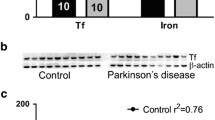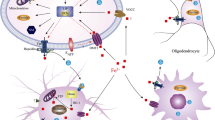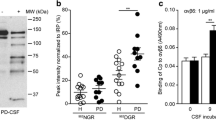Abstract
Elevated iron levels in the substantia nigra (SN) participate in neuronal death in Parkinson’s disease (PD), while the mechanisms underlying the increased iron are still unknown. Ceruloplasmin (CP), a ferroxidase, converts highly toxic ferrous iron to its non-toxic ferric form, which cooperated with ferroportin1 (FP1) facilitating the export of iron from cells. To elucidate if the abnormal expression of CP is involved in the nigral iron accumulation, here, we investigated CP expression in the SN of rats lesioned by 6-hydroxydopamine (6-OHDA). We showed that FP1 and CP colocalized in the rat SN. One day after 6-OHDA lesion, when there was a half reduction in the number of dopaminergic neurons, the iron level was increased compared with the normal rats; both the mRNA and protein expressions of CP decreased compared with the control. When rats began showing rotation behavior induced by apomorphine, usually after 6 weeks since 6-OHDA lesion, they are considered PD models. In these PD models, almost no dopaminergic neurons can be detected in the lesioned SN and nigral iron level was further increased. At this time point, a further decrease of CP was observed. These results show that FP1 and CP colocalize in the rat brain, indicating the coordinated actions of the two proteins in the cellular iron export, and suggest that decreased expression of CP in the SN is involved in the nigral iron accumulation of 6-OHDA-lesioned rats.




Similar content being viewed by others
References
Abboud S, Haile DJ (2000) A novel mammalian iron-regulated protein involved in intracellular iron metabolism. J Biol Chem 275:19906–19912
Arnal N, Cristalli DO, de Alaniz MJ, Marra CA (2010) Clinical utility of copper, ceruloplasmin, and metallothionein plasma determinations in human neurodegenerative patients and their first-degree relatives. Brain Res 1319:118–130
Ayton S, Lei P, Duce JA, Wong BX, Sedjahtera A, Adlard PA, Bush AI, Finkelstein DI (2013) Ceruloplasmin dysfunction and therapeutic potential for Parkinson disease. Ann Neurol 73:554–559
Ayton S, Lei P, Adlard PA, Volitakis I, Cherny RA, Bush AI, Finkelstein DI (2014) Iron accumulation confers neurotoxicity to a vulnerable population of nigral neurons: implications for Parkinson’s disease. Molecular Neurodegener 9:27
Bharucha KJ, Friedman JK, Vincent AS, Ross ED (2008) Lower serum ceruloplasmin levels correlate with younger age of onset in Parkinson’s disease. J Neurol 255:1957–1962
Bisaglia M, Mammi S, Bubacco L (2009) Structural insights on physiological functions and pathological effects of alpha-synuclein. FASEB J 23:329–340
Boll MC, Sotelo J, Otero E, Alcaraz-Zubeldia M, Rios C (1999) Reduced ferroxidase activity in the cerebrospinal fluid from patients with Parkinson’s disease. Neurosci Lett 265:155–158
Bradbury MW (1997) Transport of iron in the blood-brain-cerebrospinal fluid system. J Neurochem 69:443–454
Burdo JR, Menzies SL, Simpson IA, Garrick LM, Garrick MD, Dolan KG, Haile DJ, Beard JL, Connor JR (2001) Distribution of divalent metal transporter 1 and metal transport protein 1 in the normal and Belgrade rat. J Neurosci Res 66:1198–1207
De Domenico I, Ward DM, di Patti MC, Jeong SY, David S, Musci G, Kaplan J (2007) Ferroxidase activity is required for the stability of cell surface ferroportin in cells expressing GPI-ceruloplasmin. EMBO J 26:2823–2831
Dickinson TK, Connor JR (1995) Cellular distribution of iron, transferrin, and ferritin in the hypotransferrinemic (Hp) mouse brain. J Comp Neurol 355:67–80
Donovan A, Brownlie A, Zhou Y, Shepard J, Pratt SJ, Moynihan J, Paw BH, Drejer A, Barut B, Zapata A, Law TC, Brugnara C, Lux SE, Pinkus GS, Pinkus JL, Kingsley PD, Palis J, Fleming MD, Andrews NC, Zon LI (2000) Positional cloning of zebrafish ferroportin 1 identifies a conserved vertebrate iron exporter. Nature 403:776–781
Earl CD, Reum T, Xie JX, Sautter J, Kupsch A, Oertel WH, Morgenstern R (1996) Foetal nigral cell suspension grafts influence dopamine release in the non-grafted side in the 6-hydroxydopamine rat model of Parkinson’s disease: in vivo voltammetric data. Exp Brain Res 109:179–184
Fortna RR, Watson HA, Nyquist SE (1999) Glycosyl phosphatidylinositol-anchored ceruloplasmin is expressed by rat Sertoli cells and is concentrated in detergent-insoluble membrane fractions. Biol Reprod 61:1042–1049
Harris ZL, Durley AP, Man TK, Gitlin JD (1999) Targeted gene disruption reveals an essential role for ceruloplasmin in cellular iron efflux. Proc Natl Acad Sci USA 96:10812–10817
Jiang H, Qian ZM, Xie JX (2003) Increased DMT1 expression and iron content in MPTP-treated C57BL/6 mice. Sheng Li Xue Bao 55:571–576
Jin L, Wang J, Zhao L, Jin H, Fei G, Zhang Y, Zeng M, Zhong C (2011) Decreased serum ceruloplasmin levels characteristically aggravate nigral iron deposition in Parkinson’s disease. Brain 134:50–58
Kaneko K, Hineno A, Yoshida K, Ikeda S (2008) Increased vulnerability to rotenone-induced neurotoxicity in ceruloplasmin-deficient mice. Neurosci Lett 446:56–58
Kaplan J, Kushner JP (2000) Mining the genome for iron. Nature 403(711):713
Kooyman DL, Byrne GW, McClellan S, Nielsen D, Tone M, Waldmann H, Coffman TM, McCurry KR, Platt JL, Logan JS (1995) In vivo transfer of GPI-linked complement restriction factors from erythrocytes to the endothelium. Science 269:89–92
Le NT, Richardson DR (2002) Ferroportin1: a new iron export molecule? Int J Biochem Cell Biol 34:103–108
Liu B, Xie J (2004) Increased dopamine release in vivo by estradiol benzoate from the central amygdaloid nucleus of Parkinson’s disease model rats. J Neurochem 90:654–658
Martin WR, Wieler M, Gee M (2008) Midbrain iron content in early Parkinson disease: a potential biomarker of disease status. Neurology 70:1411–1417
Mastroberardino PG, Hoffman EK, Horowitz MP, Betarbet R, Taylor G, Cheng D, Na HM, Gutekunst CA, Gearing M, Trojanowski JQ, Anderson M, Chu CT, Peng J, Greenamyre JT (2009) A novel transferrin/TfR2-mediated mitochondrial iron transport system is disrupted in Parkinson’s disease. Neurobiol Dis 34:417–431
McKie AT, Marciani P, Rolfs A, Brennan K, Wehr K, Barrow D, Miret S, Bomford A, Peters TJ, Farzaneh F, Hediger MA, Hentze MW, Simpson RJ (2000) A novel duodenal iron-regulated transporter, IREG1, implicated in the basolateral transfer of iron to the circulation. Mol Cell 5:299–309
Mittal B, Doroudchi MM, Jeong SY, Patel BN, David S (2003) Expression of a membrane-bound form of the ferroxidase ceruloplasmin by leptomeningeal cells. Glia 41:337–346
Morita H, Ikeda S, Yamamoto K, Morita S, Yoshida K, Nomoto S, Kato M, Yanagisawa N (1995) Hereditary ceruloplasmin deficiency with hemosiderosis: a clinicopathological study of a Japanese family. Ann Neurol 37:646–656
Morris CM, Candy JM, Oakley AE, Bloxham CA, Edwardson JA (1992) Histochemical distribution of non-haem iron in the human brain. Acta Anat (Basel) 144:235–257
Musci G, Polticelli F, Bonaccorsi di Patti MC (2014) Ceruloplasmin-ferroportin system of iron traffic in vertebrates. World J Biol Chem 5:204–215
Pal A, Prasad R (2014) Recent discoveries on the functions of astrocytes in the copper homeostasis of the brain: a brief update. Neurotox Res 26:78–84
Pal A, Vasishta Rk, Prasad R (2013) Hepatic and hippocampus iron status is not altered in response to increased serum ceruloplasmin and serum “free” copper in Wistar rat model for non-Wilsonian brain copper toxicosis. Biol Trace Elem Res 154:403–411
Pal A, Kumar A, Prasad R (2014) Predictive association of copper metabolism proteins with Alzheimer’s disease and Parkinson’s disease: a preliminary perspective. Biometals 27:25–31
Patel BN, David S (1997) A novel glycosylphosphatidylinositol-anchored form of ceruloplasmin is expressed by mammalian astrocytes. J Biol Chem 272:20185–20190
Qian ZM, Shen X (2001) Brain iron transport and neurodegeneration. Trends in molecular medicine 7:103–108
Rouault TA (2001) Iron on the brain. Nat Genet 28:299–300
Salazar J, Mena N, Hunot S, Prigent A, Alvarez-Fischer D, Arredondo M, Duyckaerts C, Sazdovitch V, Zhao L, Garrick LM, Nunez MT, Garrick MD, Raisman-Vozari R, Hirsch EC (2008) Divalent metal transporter 1 (DMT1) contributes to neurodegeneration in animal models of Parkinson’s disease. Proc Natl Acad Sci USA 105:18578–18583
Sayre LM, Perry G, Atwood CS, Smith MA (2000) The role of metals in neurodegenerative diseases. Cell Mol Biol (Noisy-le-grand) 46:731–741
Settivari R, Levora J, Nass R (2009) The divalent metal transporter homologues SMF-1/2 mediate dopamine neuron sensitivity in caenorhabditis elegans models of manganism and parkinson disease. J Biol Chem 284:35758–35768
Shim H, Harris ZL (2003) Genetic defects in copper metabolism. J Nutr 133:1527S–1531S
Vulpe CD, Kuo YM, Murphy TL, Cowley L, Askwith C, Libina N, Gitschier J, Anderson GJ (1999) Hephaestin, a ceruloplasmin homologue implicated in intestinal iron transport, is defective in the sla mouse. Nat Genet 21:195–199
Wang J, Jiang H, Xie JX (2007) Ferroportin1 and hephaestin are involved in the nigral iron accumulation of 6-OHDA-lesioned rats. Eur J Neurosci 25:2766–2772
Xu X, Pin S, Gathinji M, Fuchs R, Harris ZL (2004) Aceruloplasminemia: an inherited neurodegenerative disease with impairment of iron homeostasis. Ann N Y Acad Sci 1012:299–305
Yoshida K, Furihata K, Takeda S, Nakamura A, Yamamoto K, Morita H, Hiyamuta S, Ikeda S, Shimizu N, Yanagisawa N (1995) A mutation in the ceruloplasmin gene is associated with systemic hemosiderosis in humans. Nat Genet 9:267–272
Zecca L, Youdim MB, Riederer P, Connor JR, Crichton RR (2004) Iron, brain ageing and neurodegenerative disorders. Nat Rev Neurosci 5:863–873
Zhao N, Jin L, Fei G, Zheng Z, Zhong C (2014) Serum microRNA-133b is associated with low ceruloplasmin levels in Parkinson’s disease. Parkinsonism Relat Disord 20:1177–1180
Zhou Y, Zhao ZQ, Xie JX (2001) Effects of isatin on rotational behavior and DA levels in caudate putamen in Parkinsonian rats. Brain Res 917:127–132
Acknowledgments
This work was supported by grants from the National Program of Basic Research sponsored by the Ministry of Science and Technology of China (2011CB504102), and the National Foundation of Natural Science of China (31171031, 81430024).
Conflict of interest
There are no conflicts of interest.
Author information
Authors and Affiliations
Corresponding authors
Electronic supplementary material
Below is the link to the electronic supplementary material.
Rights and permissions
About this article
Cite this article
Wang, J., Bi, M. & Xie, J. Ceruloplasmin is Involved in the Nigral Iron Accumulation of 6-OHDA-Lesioned Rats. Cell Mol Neurobiol 35, 661–668 (2015). https://doi.org/10.1007/s10571-015-0161-2
Received:
Accepted:
Published:
Issue Date:
DOI: https://doi.org/10.1007/s10571-015-0161-2




